sensor Citroen JUMPY RHD 2016 2.G User Guide
[x] Cancel search | Manufacturer: CITROEN, Model Year: 2016, Model line: JUMPY RHD, Model: Citroen JUMPY RHD 2016 2.GPages: 520, PDF Size: 10.54 MB
Page 159 of 520
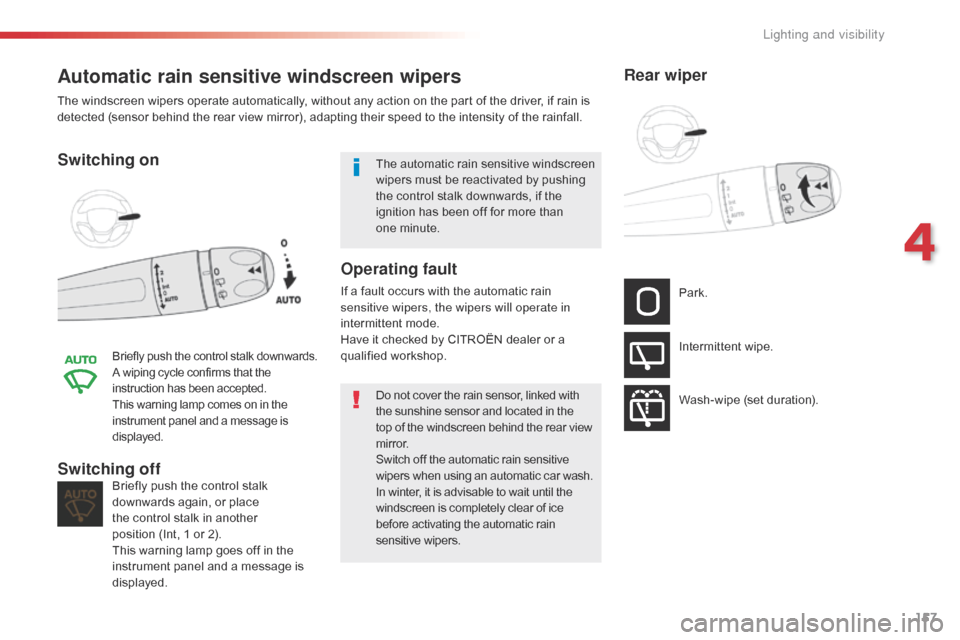
157
Automatic rain sensitive windscreen wipers
Switching on
Briefly push the control stalk downwards.
A wiping cycle confirms that the
instruction has been accepted.
This warning lamp comes on in the
instrument panel and a message is
displayed.
Briefly push the control stalk
downwards again, or place
the control stalk in another
position (Int, 1 or 2).
This warning lamp goes off in the
instrument panel and a message is
displayed.Switching off
The automatic rain sensitive windscreen
wipers must be reactivated by pushing
the control stalk downwards, if the
ignition has been off for more than
one
minute.
The windscreen wipers operate automatically, without any action on the part of the driver, if rain is
detected (sensor behind the rear view mirror), adapting their speed to the intensity of the rainfall.
Do not cover the rain sensor, linked with
the sunshine sensor and located in the
top of the windscreen behind the rear view
m i r r o r.
Switch off the automatic rain sensitive
wipers when using an automatic car wash.
In winter, it is advisable to wait until the
windscreen is completely clear of ice
before activating the automatic rain
sensitive wipers.
Operating fault
If a fault occurs with the automatic rain
sensitive wipers, the wipers will operate in
intermittent mode.
Have it checked by CITROËN dealer or a
qualified workshop. Park.
Intermittent wipe.
Wash-wipe (set duration).
Rear wiper
4
Lighting and visibility
Page 175 of 520
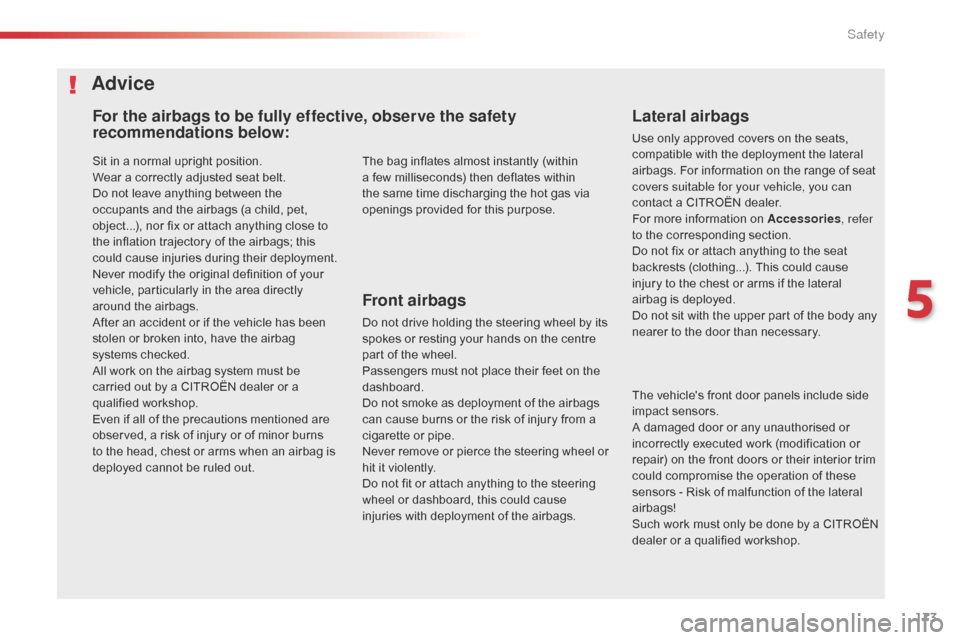
173
Sit in a normal upright position.
Wear a correctly adjusted seat belt.
Do not leave anything between the
occupants and the airbags (a child, pet,
object...), nor fix or attach anything close to
the inflation trajectory of the airbags; this
could cause injuries during their deployment.
Never modify the original definition of your
vehicle, particularly in the area directly
around the airbags.
After an accident or if the vehicle has been
stolen or broken into, have the airbag
systems checked.
All work on the airbag system must be
carried out by a CITROËN dealer or a
qualified workshop.
Even if all of the precautions mentioned are
observed, a risk of injury or of minor burns
to the head, chest or arms when an airbag is
deployed cannot be ruled out.
Lateral airbags
Use only approved covers on the seats,
compatible with the deployment the lateral
airbags. For information on the range of seat
covers suitable for your vehicle, you can
contact a CITROËN dealer.
For more information on Accessories , refer
to the corresponding section.
Do not fix or attach anything to the seat
backrests (clothing...). This could cause
injury to the chest or arms if the lateral
airbag is deployed.
Do not sit with the upper part of the body any
nearer to the door than necessary.
The bag inflates almost instantly (within
a few milliseconds) then deflates within
the same time discharging the hot gas via
openings provided for this purpose.
Front airbags
Do not drive holding the steering wheel by its
spokes or resting your hands on the centre
part of the wheel.
Passengers must not place their feet on the
dashboard.
Do not smoke as deployment of the airbags
can cause burns or the risk of injury from a
cigarette or pipe.
Never remove or pierce the steering wheel or
hit it violently.
Do not fit or attach anything to the steering
wheel or dashboard, this could cause
injuries with deployment of the airbags.
Advice
For the airbags to be fully effective, observe the safety
recommendations below:
The vehicle's front door panels include side
impact sensors.
A damaged door or any unauthorised or
incorrectly executed work (modification or
repair) on the front doors or their interior trim
could compromise the operation of these
sensors - Risk of malfunction of the lateral
airbags!
Such work must only be done by a CITROËN
dealer or a qualified workshop.
5
Safety
Page 200 of 520
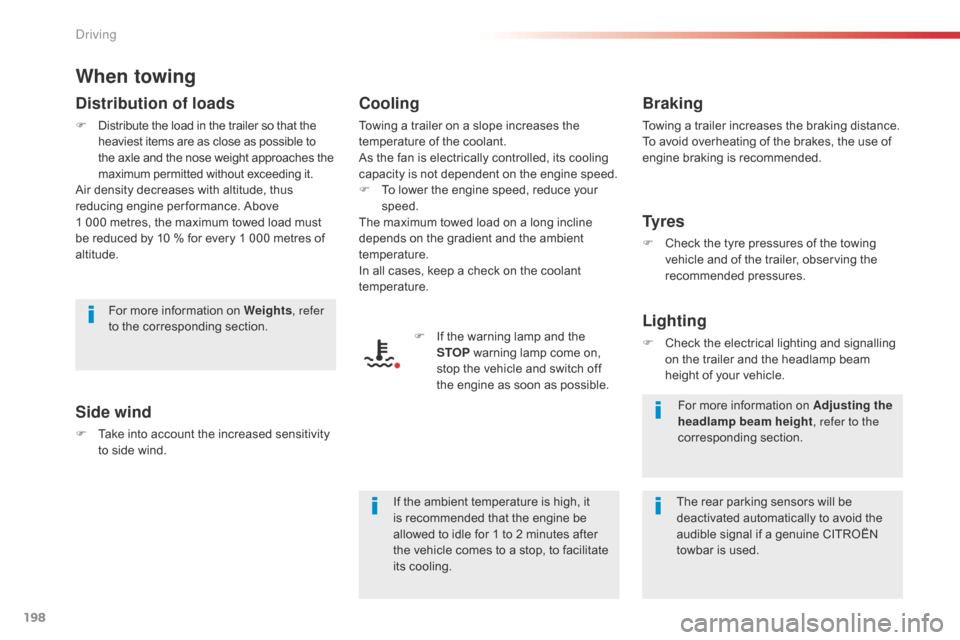
198
When towing
Distribution of loads
F Distribute the load in the trailer so that the heaviest items are as close as possible to
the axle and the nose weight approaches the
maximum permitted without exceeding it.
Air density decreases with altitude, thus
reducing engine per formance. Above
1
000 metres, the maximum towed load must
be reduced by 10
% for every 1 000 metres of
altitude.
Side wind
F Take into account the increased sensitivity to side wind.
Cooling
Towing a trailer on a slope increases the
temperature of the coolant.
As the fan is electrically controlled, its cooling
capacity is not dependent on the engine speed.
F
T
o lower the engine speed, reduce your
speed.
The maximum towed load on a long incline
depends on the gradient and the ambient
temperature.
In all cases, keep a check on the coolant
temperature.
F
I
f the warning lamp and the
STOP warning lamp come on,
stop the vehicle and switch off
the engine as soon as possible.
Braking
Towing a trailer increases the braking distance.
To avoid overheating of the brakes, the use of
engine braking is recommended.
Ty r e s
F Check the tyre pressures of the towing vehicle and of the trailer, observing the
recommended pressures.
Lighting
F Check the electrical lighting and signalling on the trailer and the headlamp beam
height of your vehicle.
For more information on Weights
, refer
to the corresponding section.
The rear parking sensors will be
deactivated automatically to avoid the
audible signal if a genuine CITROËN
towbar is used.
If the ambient temperature is high, it
is recommended that the engine be
allowed to idle for 1 to 2 minutes after
the vehicle comes to a stop, to facilitate
its cooling. For more information on Adjusting the
headlamp beam height
, refer to the
corresponding section.
Driving
Page 250 of 520

248
Clean the front bumper, removing the
snow, mud, ... If one of the two sensors (camera
or radar) is masked or its visibility
is reduced, while the other sensor
is able to work normally, the system
still operates, but at a lower level of
per formance. This is not indicated by a
message or a warning lamp.
To ensure correct operation of the radar
radar, do not paint over the paintwork
on the vehicle's bumper.
Keep the windscreen in front of the
camera clean.
Do not allow snow to accumulate on
the bonnet or roof of the vehicle as this
could mask the camera's view.
Lane departure warning system
System that uses a camera to recognise
continuous or broken lines on traffic lanes and
triggers an alert if the vehicle wanders off line.
If the direction indicator is not used at speeds
above 37 mph (60 km/h) and there is a risk of
one of these lines on the ground being crossed,
the system triggers the alert.
The system is particularly useful on motor ways
and fast roads.
Detection - Alert
You are alerted by the flashing of
this warning lamp in the instrument
panel, accompanied by an audible
signal.
No alert is given while the direction
indicators are operating and for
approximately 20 seconds after the
direction indicators are switched off.
The lane departure warning system
cannot in any circumstances replace
the need for vigilance on the part of the
driver.
It is necessary to observe the driving
regulations and to take a break every
two hours.
Driving
Page 254 of 520

252
Blind spot monitoring system
A warning lamp appears in the door mirror on
the side in question:
-
i
mmediately, when being overtaken,
-
a
fter a delay of about one second, when
overtaking a vehicle slowly.
This driving assistance system warns the driver
of the presence of another vehicle in the blind
spot angle of their vehicle (areas masked from
the driver's field of vision), as soon as this
presents a potential danger. The alert is given by a warning lamp which
comes on in the door mirror on the side in
question as soon as a vehicle - car, lorry,
bicycle - is detected and the following
conditions are fulfilled:
-
a
ll the vehicles must be moving in the
same direction and on adjacent lanes,
-
t
he speed of your vehicle is between 7 and
87 mph (12 and 140 km/h),
-
w
hen you overtake a vehicle with a speed
difference of less than 6 mph (10 km/h),
- w hen a vehicle overtakes you with a speed
difference of less than 15 mph (25 km/h),
-
t
he traffic must be flowing normally,
-
i
n the case of an overtaking manoeuvre,
if this is prolonged and the vehicle being
overtaken returns to the blind spot,
-
y
ou are driving on a straight or slightly
curved road,
-
y
our vehicle is not pulling a trailer, a
caravan...
This system is designed to improve
safety when driving and is in no
circumstances a substitute for the use
of the interior rear view mirror and door
mirrors. It is the driver's responsibility to
constantly check the traffic, to assess
the distances and relative speeds
of other vehicles and to predict their
movements before deciding whether to
change lane.
The blind spot sensor system does not
replace the need for vigilance on the
part of the driver.
D
Page 256 of 520

254
Operating fault
Have it checked by a CITROËN dealer or a
qualified workshop.The system may suffer temporary
interference in certain weather
conditions (rain, hail...).
In particular, driving on a wet sur face
or moving from a dry area to a wet area
can cause false alerts (for example, the
presence of a fog of water droplets in
the blind spot angle is interpreted as a
vehicle).
In bad or wintry weather, ensure that
the sensors are not covered by mud,
ice or snow.
Take care not to cover the warning zone
in the door mirrors or the detection
zones on the front and rear bumpers
with adhesive labels or other objects;
they may hamper the correct operation
of the system.
Depending on your vehicle's equipment:
With the touch screen
In the Driving
menu, activate/deactivate " Blind
spot monitoring ".
In the event of a fault, these warning lamps
flash.
The indicator lamp in this button
flashes and a message appears,
accompanied by an audible signal.
The state of the system remains in
memory on switching off the ignition.
The system is automatically deactivated
when towing with a towbar approved by
CITROËN.
High pressure jet wash
When washing your vehicle, do not
place the tip of the lance within 30 cm
of the sensors as otherwise there is a
risk of damaging them.
or
Driving
Page 257 of 520
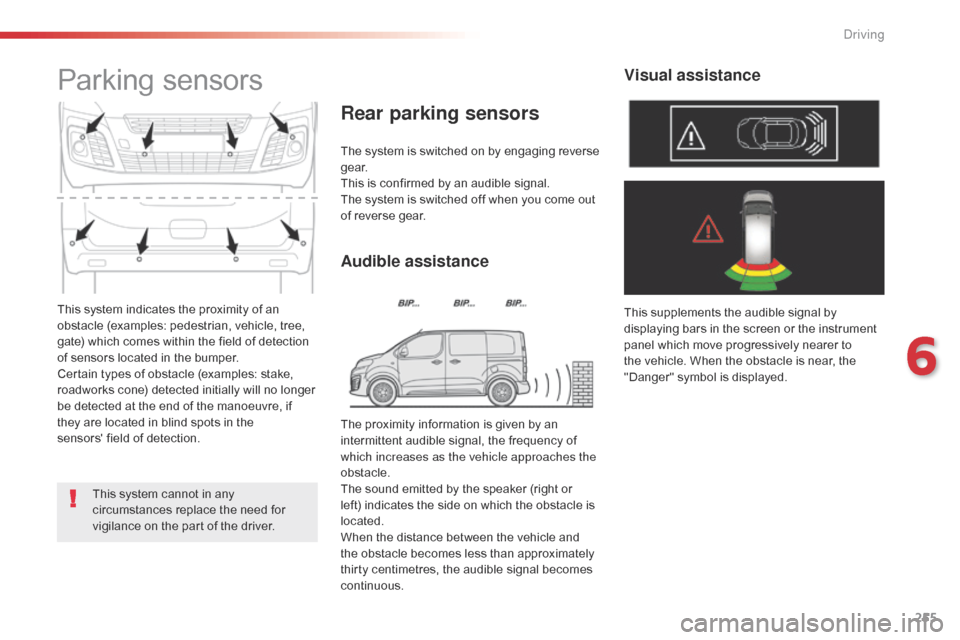
255
This system indicates the proximity of an
obstacle (examples: pedestrian, vehicle, tree,
gate) which comes within the field of detection
of sensors located in the bumper.
Certain types of obstacle (examples: stake,
roadworks cone) detected initially will no longer
be detected at the end of the manoeuvre, if
they are located in blind spots in the
sensors' field of detection.
Parking sensors
The system is switched on by engaging reverse
g e a r.
This is confirmed by an audible signal.
The system is switched off when you come out
of reverse gear.
Audible assistance
Rear parking sensors
This supplements the audible signal by
displaying bars in the screen or the instrument
panel which move progressively nearer to
the vehicle. When the obstacle is near, the
"Danger" symbol is displayed.
Visual assistance
This system cannot in any
circumstances replace the need for
vigilance on the part of the driver.The proximity information is given by an
intermittent audible signal, the frequency of
which increases as the vehicle approaches the
obstacle.
The sound emitted by the speaker (right or
left) indicates the side on which the obstacle is
located.
When the distance between the vehicle and
the obstacle becomes less than approximately
thirty centimetres, the audible signal becomes
continuous.
6
Driving
Page 258 of 520
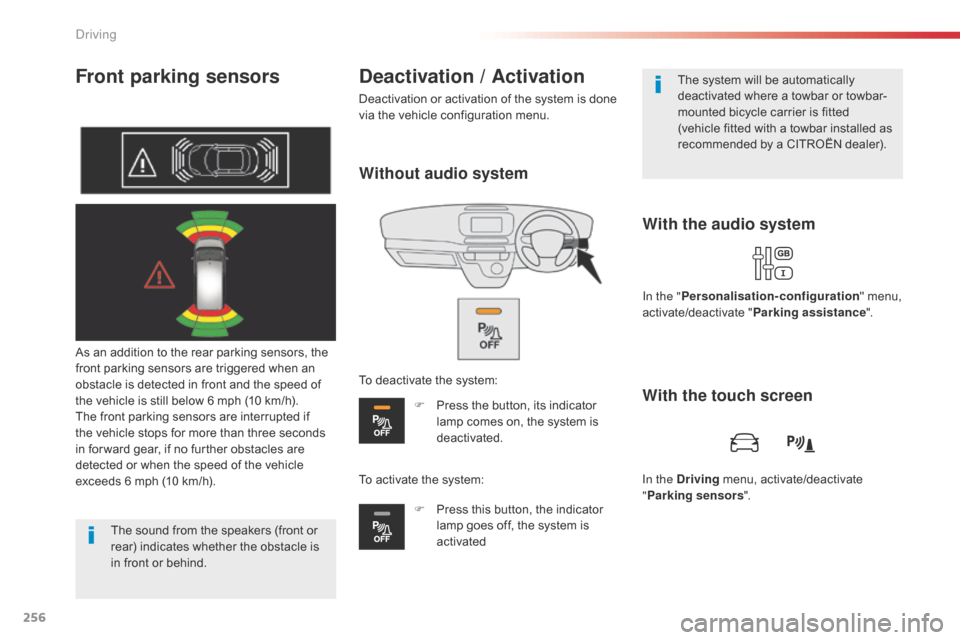
256
Front parking sensors
As an addition to the rear parking sensors, the
front parking sensors are triggered when an
obstacle is detected in front and the speed of
the vehicle is still below 6 mph (10 km/h).
The front parking sensors are interrupted if
the vehicle stops for more than three seconds
in for ward gear, if no further obstacles are
detected or when the speed of the vehicle
exceeds 6 mph (10 km/h).
With the audio system
Deactivation / Activation
Deactivation or activation of the system is done
via the vehicle configuration menu.
The sound from the speakers (front or
rear) indicates whether the obstacle is
in front or behind. The system will be automatically
deactivated where a towbar or towbar-
mounted bicycle carrier is fitted
(vehicle fitted with a towbar installed as
recommended by a CITROËN dealer).
In the " Personalisation-configuration " menu,
activate/deactivate " Parking assistance ".
With the touch screen
In the Driving menu, activate/deactivate
" Parking sensors ".
Without audio system
To deactivate the system:
F
P
ress the button, its indicator
lamp comes on, the system is
deactivated.
To activate the system: F
P
ress this button, the indicator
lamp goes off, the system is
activated
Driving
Page 259 of 520
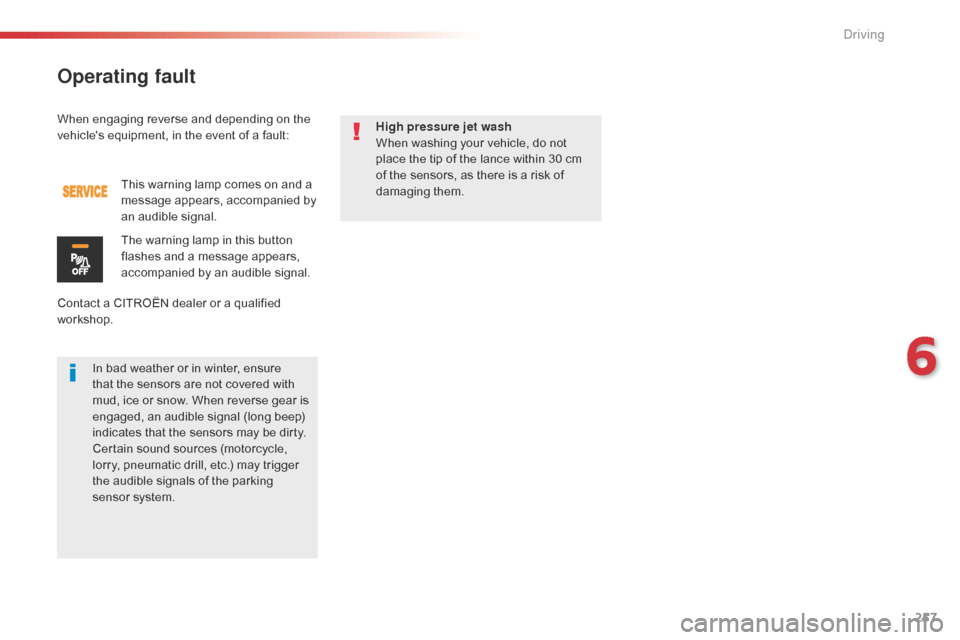
257
When engaging reverse and depending on the
vehicle's equipment, in the event of a fault:
Contact a CITROËN dealer or a qualified
workshop.This warning lamp comes on and a
message appears, accompanied by
an audible signal.
The warning lamp in this button
flashes and a message appears,
accompanied by an audible signal.
In bad weather or in winter, ensure
that the sensors are not covered with
mud, ice or snow. When reverse gear is
engaged, an audible signal (long beep)
indicates that the sensors may be dirty.
Certain sound sources (motorcycle,
lorry, pneumatic drill, etc.) may trigger
the audible signals of the parking
sensor system. High pressure jet wash
When washing your vehicle, do not
place the tip of the lance within 30 cm
of the sensors, as there is a risk of
damaging them.
Operating fault
6
Driving
Page 260 of 520
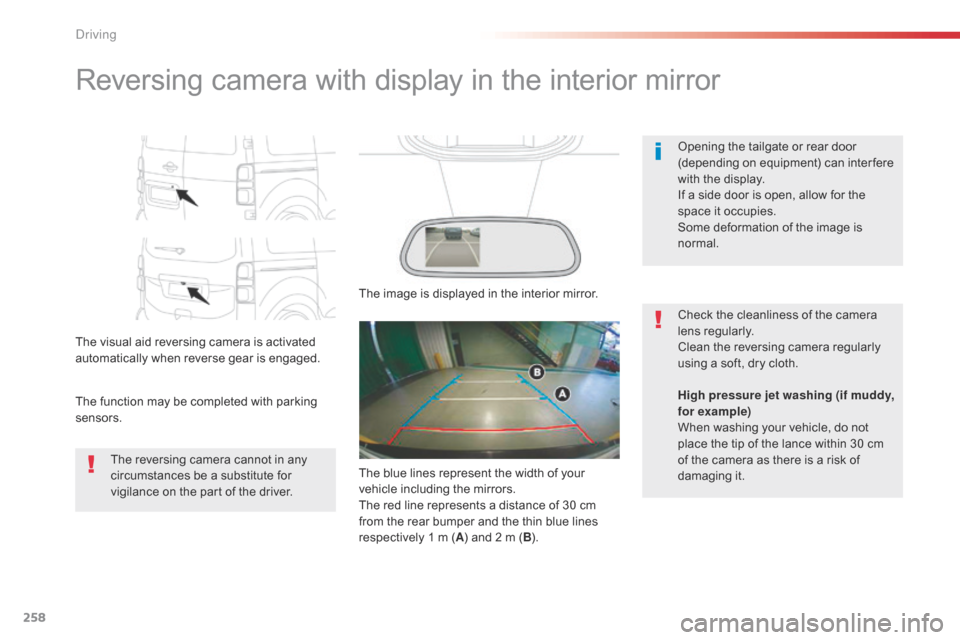
258
Reversing camera with display in the interior mirror
The visual aid reversing camera is activated
automatically when reverse gear is engaged.
The function may be completed with parking
sensors.Opening the tailgate or rear door
(depending on equipment) can inter fere
with the display.
If a side door is open, allow for the
space it occupies.
Some deformation of the image is
normal.
The reversing camera cannot in any
circumstances be a substitute for
vigilance on the part of the driver. Check the cleanliness of the camera
lens regularly.
Clean the reversing camera regularly
using a soft, dry cloth.
The image is displayed in the interior mirror.
High pressure jet washing (if muddy,
for example)
When washing your vehicle, do not
place the tip of the lance within 30
cm
of the camera as there is a risk of
damaging it.
The blue lines represent the width of your
vehicle including the mirrors.
The red line represents a distance of 30 cm
from the rear bumper and the thin blue lines
respectively 1 m (
A) and 2 m ( B).
Driving